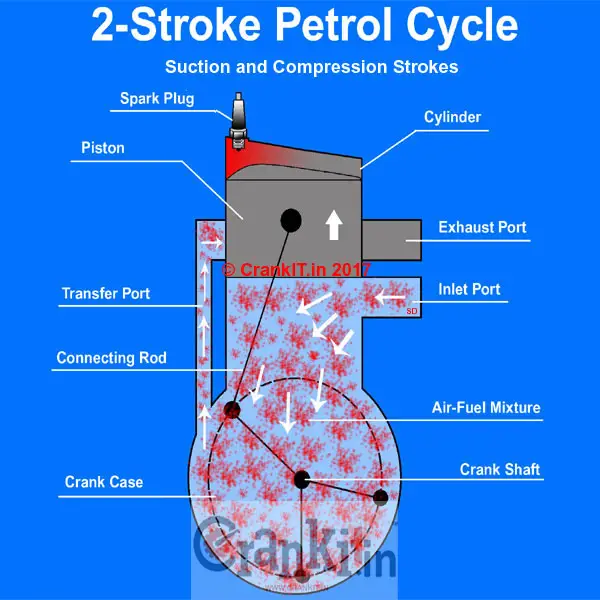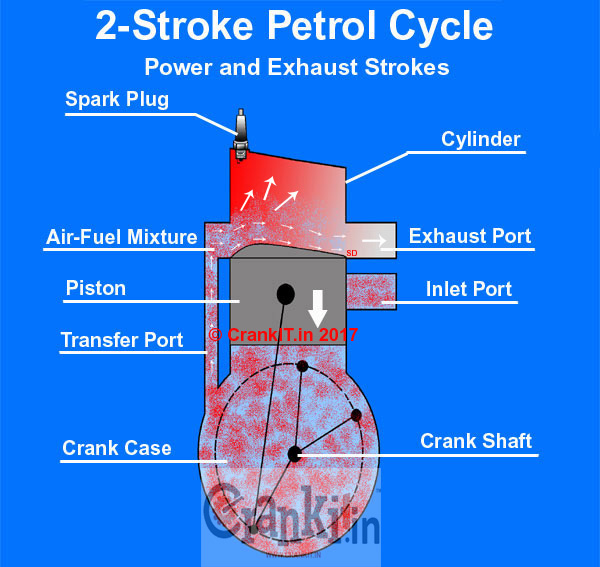What is A 2 Stroke Spark Ignition Cycle?
Although 2-stroke spark ignition cycle (2-stroke petrol) engines are not much in use in most countries, they are still part of the legacy of types of engines worldwide. A 2-stroke petrol engine differs from a 4-stroke petrol engine by the way it generates power in the number of revolutions of the crankshaft. Unlike a 4-stroke petrol engine, the 2-stroke spark ignition cycle produces power in each of its revolutions. This cycle gives way to the traditional four strokes to run its complete cycle. Instead, it merges two strokes into one, making one upward stroke and one downward stroke in every revolution of the crankshaft.
Hence, the 2-stroke petrol engine generates power during each downward stroke of the piston. Thus, it produces double the power output compared to a 4-stroke cycle engine of the same size. However, the efficiency of the 2-stroke cycle petrol engine is lower compared to a 4-stroke petrol engine of the same size. It is because this ignition cycle eliminates the suction and exhaust strokes. Instead, it uses the two remaining strokes, the compression, and power strokes. These are known as the upward stroke and downward stroke, respectively.
Upward Stroke:
During the upward stroke of a 2-stroke spark ignition cycle, the piston moves upward, i.e., from the bottom dead center to the top dead center. While moving up, it compresses the air-fuel mixture in the combustion chamber. In addition, the upward movement of the piston creates a partial vacuum in the crankcase. Thus it results in a fresh charge (air-fuel mixture) coming into the crankcase thru’ the open inlet port.

When the piston is at the top dead center, it covers/closes the exhaust and transfer ports. Next, the spark plug ignites the compressed charge in the combustion chamber and produces the power stroke. The power stroke pushes the piston downward and rotates the crankshaft.
Downward Stroke:
As soon as the spark plug ignites the charge in a 2 stroke cycle, the hot gases expand and push the piston downward, rotating the crankshaft. During this stroke, the piston covers the inlet port and compresses the crankcase’s new charge (air-fuel mixture). Further downward movement of the piston first uncovers the exhaust port, followed by the transfer port. Thus, exhaust gases can escape through the open exhaust port.

No sooner does the transfer port open; than forcing the fresh charge into the cylinder. The charge first strikes the deflector on the piston crown, rises to the top of the cylinder, and pushes out the remaining exhaust gases. Some part of the fresh charge also escapes through the exhaust during this process. Because of this reason, the 2 stroke spark ignition cycle does not meet the stringent emission norms. Hence, manufacturers later discontinued it and replaced it with a 4 stroke cycle.
Now, the piston is at the bottom dead center. The cylinder is completely filled with fresh charge and somewhat diluted with the remaining exhaust gases. The engine burns this charge during the next upward stroke. This cycle repeats itself and the piston makes two strokes for each revolution of the crankshaft.
Most earlier-generation motorcycles, bikes, scooters, and small gen-sets used this ignition cycle engine.
Watch A 2 Stroke Spark Ignition Cycle Engine In Action Here:
Continue Reading: How a Four Stroke Petrol Engine Works.>>
